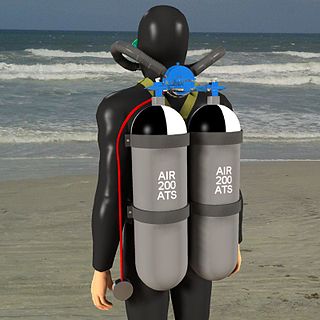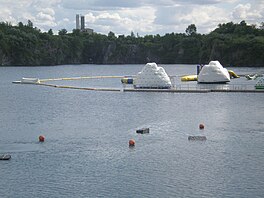
A scuba set, originally just scuba, is any breathing apparatus that is entirely carried by an underwater diver and provides the diver with breathing gas at the ambient pressure. Scuba is an anacronym for self-contained underwater breathing apparatus. Although strictly speaking the scuba set is only the diving equipment that is required for providing breathing gas to the diver, general usage includes the harness by which it is carried, and those accessories which are integral parts of the harness and breathing apparatus assembly, such as a jacket or wing style buoyancy compensator and instruments mounted in a combined housing with the pressure gauge, and in the looser sense, it has been used to refer to all the diving equipment used by the scuba diver, though this would more commonly and accurately be termed scuba equipment or scuba gear. Scuba is overwhelmingly the most common underwater breathing system used by recreational divers and is also used in professional diving when it provides advantages, usually of mobility and range, over surface supplied diving systems, and is allowed by the relevant legislation and code of practice.

Aqua-Lung was the first open-circuit, self-contained underwater breathing apparatus to achieve worldwide popularity and commercial success. This class of equipment is now commonly referred to as a twin-hose diving regulator, or demand valve. The Aqua-Lung was invented in France during the winter of 1942–1943 by two Frenchmen: engineer Émile Gagnan and Jacques Cousteau, who was a Naval Lieutenant. It allowed Cousteau and Gagnan to film and explore underwater more easily.

Technical diving is scuba diving that exceeds the agency-specified limits of recreational diving for non-professional purposes. Technical diving may expose the diver to hazards beyond those normally associated with recreational diving, and to a greater risk of serious injury or death. The risk may be reduced by appropriate skills, knowledge and experience, and by using suitable equipment and procedures. The skills may be developed through appropriate specialised training and experience. The equipment often involves breathing gases other than air or standard nitrox mixtures, and multiple gas sources.

Deep diving is underwater diving to a depth beyond the norm accepted by the associated community. In some cases this is a prescribed limit established by an authority, while in others it is associated with a level of certification or training, and it may vary depending on whether the diving is recreational, technical or commercial. Nitrogen narcosis becomes a hazard below 30 metres (98 ft) and hypoxic breathing gas is required below 60 metres (200 ft) to lessen the risk of oxygen toxicity.
The National Association of Underwater Instructors is a non-profit association of scuba instructors. It primarily serves as a recreational dive certification and membership organization established to provide international diver standards and education programs. The agency was founded in 1960 by Albert Tillman and Neal Hess. NAUI is headquartered in the Tampa, Florida area with dive and member instructors, resorts, stores, service and training centers, located around the world.

Recreational diving or sport diving is diving for the purpose of leisure and enjoyment, usually when using scuba equipment. The term "recreational diving" may also be used in contradistinction to "technical diving", a more demanding aspect of recreational diving which requires more training and experience to develop the competence to reliably manage more complex equipment in the more hazardous conditions associated with the disciplines. Breath-hold diving for recreation also fits into the broader scope of the term, but this article covers the commonly used meaning of scuba diving for recreational purposes, where the diver is not constrained from making a direct near-vertical ascent to the surface at any point during the dive, and risk is considered low.

Police diving is a branch of professional diving carried out by police services. Police divers are usually sworn police officers, and may either be employed full-time as divers or as general water police officers, or be volunteers who usually serve in other units but are called in if their diving services are required.
(Captain) Trevor Hampton AFC was one of the United Kingdom's first scuba divers and helped to develop sport diving in the UK.

Underwater diving, as a human activity, is the practice of descending below the water's surface to interact with the environment. It is also often referred to as diving, an ambiguous term with several possible meanings, depending on context. Immersion in water and exposure to high ambient pressure have physiological effects that limit the depths and duration possible in ambient pressure diving. Humans are not physiologically and anatomically well-adapted to the environmental conditions of diving, and various equipment has been developed to extend the depth and duration of human dives, and allow different types of work to be done.

Advanced Open Water Diver (AOWD) is a recreational scuba diving certification level provided by several diver training agencies. Agencies offering this level of training under this title include Professional Association of Diving Instructors (PADI), and Scuba Schools International (SSI). Other agencies offer similar training under different titles. Advanced Open Water Diver is one step up from entry level certification as a beginner autonomous scuba diver. A major difference between Autonomous diver equivalent Open Water Diver (OWD) certification and AOWD is that the depth limit is increased from 18 to 30 metres.

Canoe diving and Kayak diving are recreational diving where the divers paddle to a diving site in a canoe or kayak carrying all their gear in or on the boat to the place they want to dive. Canoe or kayak diving gives the diver independence from dive boat operators, while allowing dives at sites which are too far to comfortably swim, but are sufficiently sheltered.

Wazee Lake is a lake east of Black River Falls, Wisconsin, in the town of Brockway, Jackson County, Wisconsin, United States. The name "Wazee" means "tall pine" in the Ho-Chunk language. The artificial lake is the deepest lake within the state of Wisconsin, with a maximum depth of approximately 355 feet (108 m). The man-made lake was formed after the site was used as a quarry for taconite mining between the mid-1960s through April 1983. The quarry produced about 850,000 tons of taconite pellets each year. The mine closed in 1983 as a result of a crash of the domestic steel markets in the United States. When the mine was in operation, pumps removed about 800 US gallons of water per minute from the quarry. Once these pumps were shut down, the quarry began filling with water.

Vintage scuba is scuba equipment dating from 1975 and earlier, and the practice of diving using such equipment.
The Homestead Caldera, known locally as "The Crater" is a natural geothermal hot spring surrounded by a rock dome. It is located in Midway, Utah.

Recreational dive sites are specific places that recreational scuba divers go to enjoy the underwater environment or for training purposes. They include technical diving sites beyond the range generally accepted for recreational diving. In this context all diving done for recreational purposes is included. Professional diving tends to be done where the job is, and with the exception of diver training and leading groups of recreational divers, does not generally occur at specific sites chosen for their easy access, pleasant conditions or interesting features.

The history of underwater diving starts with freediving as a widespread means of hunting and gathering, both for food and other valuable resources such as pearls and coral, By classical Greek and Roman times commercial applications such as sponge diving and marine salvage were established, Military diving also has a long history, going back at least as far as the Peloponnesian War, with recreational and sporting applications being a recent development. Technological development in ambient pressure diving started with stone weights (skandalopetra) for fast descent. In the 16th and 17th centuries diving bells became functionally useful when a renewable supply of air could be provided to the diver at depth, and progressed to surface supplied diving helmets—in effect miniature diving bells covering the diver's head and supplied with compressed air by manually operated pumps—which were improved by attaching a waterproof suit to the helmet and in the early 19th century became the standard diving dress.

The history of scuba diving is closely linked with the history of the equipment. By the turn of the twentieth century, two basic architectures for underwater breathing apparatus had been pioneered; open-circuit surface supplied equipment where the diver's exhaled gas is vented directly into the water, and closed-circuit breathing apparatus where the diver's carbon dioxide is filtered from the exhaled breathing gas, which is then recirculated, and more gas added to replenish the oxygen content. Closed circuit equipment was more easily adapted to scuba in the absence of reliable, portable, and economical high pressure gas storage vessels. By the mid-twentieth century, high pressure cylinders were available and two systems for scuba had emerged: open-circuit scuba where the diver's exhaled breath is vented directly into the water, and closed-circuit scuba where the carbon dioxide is removed from the diver's exhaled breath which has oxygen added and is recirculated. Oxygen rebreathers are severely depth limited due to oxygen toxicity risk, which increases with depth, and the available systems for mixed gas rebreathers were fairly bulky and designed for use with diving helmets. The first commercially practical scuba rebreather was designed and built by the diving engineer Henry Fleuss in 1878, while working for Siebe Gorman in London. His self contained breathing apparatus consisted of a rubber mask connected to a breathing bag, with an estimated 50–60% oxygen supplied from a copper tank and carbon dioxide scrubbed by passing it through a bundle of rope yarn soaked in a solution of caustic potash. During the 1930s and all through World War II, the British, Italians and Germans developed and extensively used oxygen rebreathers to equip the first frogmen. In the U.S. Major Christian J. Lambertsen invented a free-swimming oxygen rebreather. In 1952 he patented a modification of his apparatus, this time named SCUBA, an acronym for "self-contained underwater breathing apparatus," which became the generic English word for autonomous breathing equipment for diving, and later for the activity using the equipment. After World War II, military frogmen continued to use rebreathers since they do not make bubbles which would give away the presence of the divers. The high percentage of oxygen used by these early rebreather systems limited the depth at which they could be used due to the risk of convulsions caused by acute oxygen toxicity.
Valerie Olson van Heest is an American author, explorer, and museum exhibit designer. She is co-founder of the Michigan Shipwreck Research Association.














